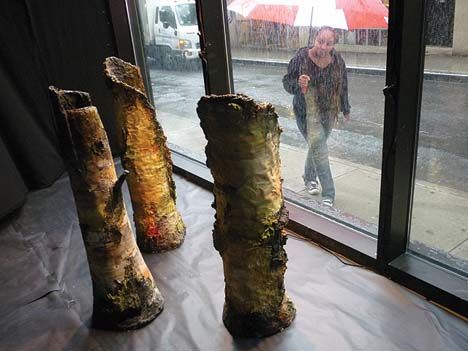 Non-profit galleries pop-up in vacant sites
Non-profit galleries pop-up in vacant sitesCurators follow their commercial counterparts
By Andrew Goldstein | Web only
Published online 25 Nov 09 (News)
A pedestrian walks by Smartspaces' recent show "Regeneration" in an vacant building in the Financial District, at 88 Greenwich Street
new york. Non-profit arts organisations and curators are following their commercial equivalents in New York, with a wave of “pop-up” galleries taking advantage of the recessionary real-estate market to strike up partnerships with realtors to stage free exhibitions. Recent non-profits using empty spaces include: No Longer Empty, the Lower Manhattan Cultural Council, the Drop: Urban Infill Project, X Initiative, the Downtown Brooklyn Alliance, and veteran non-profits Creative Time, the Art Production Fund and Chashama, which have long worked with underused sites. One new outfit, Smartspaces, has carved out a special niche—showing art exclusively in the windows of developing properties, thereby promoting both artists and real estate with minimum liability.
Even established museums such as the PS1 Contemporary Art Center in Queens is getting in on the act. Under the rubric “Free Space”, it is offering unused galleries as studios for artists—Marina Abramovic and Kalup Linzy among them—and large-scale events such as the NY Art Book Fair and the show “100 Years”, organised by Performa and Electronic Arts Intermix. Next month the center is working with Creative Time to present a one-weekend open call where artists can receive feedback from PS1, MoMA, and Creative Time curators. “It is important not to let the economy stunt creativity but rather use it is as a time to push boundaries,” says newly appointed PS1 director Klaus Biesenbach. “’Free Space’ encourages this spirit by inviting artists, collectives, and non-profits that share like-minded missions to collaborate and experiment within the building.”
Looking back to the crisis-led entrepreneurialism of the 1970s, these symbiotic arrangements have benefited from developers’ relatively recent appreciation of the economic stimulus artists can bring to a property. No Longer Empty, founded by a group of curators, has staged shows in a former fishing tackle store in Chelsea, a downtown luxury condominium, and empty factory on Brooklyn’s Bergen Street in the past few months. The exhibitions have shown artists ranging from grandees such as Yoko Ono to rising stars like Rafael Lozano-Hemmer and Michael Bevilacqua.
According to Manon Slome, one of the founders, realtors are happy to offer vacant properties for shows which can attract up to 3,000 visitors at openings. “One realtor said to me they couldn’t get as many people through the door with a $5,000 ad as we bring in,” she said. Their next show, opening at a Chelsea space on 10 December, will display a collection of cartoons about the Middle East conflict that were assembled by the Parents Circle, a group of Israeli and Palestinian parents who lost children in the Intifada. Though the group began as a reaction to the recession, she says that they hope to make it sustainable long-term and are lobbying city councils to pass legislation giving tax breaks for realtors who donate spaces.
But property owners already see a variety of incentives to provide space for art programming. In perhaps the highest-profile instance, Trinity Real Estate recently partnered with the Lower Manhattan Cultural Council (LMCC) to create LentSpace, an open-air sculpture park on an undeveloped plot downtown. “We wanted to have a temporary use there that would be more interested in a parking lot, and we reached out to the LMCC because they have a history of putting on temporary exhibitions,” says Erin Roeder, Trinity’s director of strategic neighbourhood development. The project is planned to last two years, but could end sooner or later depending on the economy. “The property will of course be more valuable when the market comes back,” she says.
Founded months before the economic crash, the non-profit Smartspaces operates on the “working hypothesis that there is a way to do this that provides value for everyone, because for this to grow on a larger scale and be sustainable through boom and bust times, everybody’s incentives have to be aligned,” says director Ellen Scott. “We found out early on in real estate it’s really about the bottom line.” Although, like the other non-profits, Smartspaces doesn’t sell any work, an artist, Kim Krans, sold a sculpture exhibited in a recent show for $15,000.
PS1 founder Alanna Heiss, who in 1971 famously began the Institute of Art and Urban Resources, a non-profit that showed avant-guard work in such vacant spaces as the caverns beneath the Brooklyn Bridge and the second floor of a Crown Heights police station, says she sees similarities between her organization and what is happening today. “There is a kind of art being made now that seems very comfortable in unusual spaces, so it’s not exactly what I was doing with installation art, but this art that is more performance or theater-based looks great in odd spaces,” she says. There are crucial differences though. The current non-profits are “working with it as a city planning, I was doing it more as a guerrilla action,” she says, adding that oftentimes her spaces didn’t even have electricity. “In my time nobody ever wanted to let me do it. I had to find ways to assure them we would leave after the show. It was like squatters. Artists would move in and they wouldn’t move out."
 Non-profit galleries pop-up in vacant sites
Non-profit galleries pop-up in vacant sites